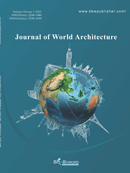Abstract
This article organizes and analyzes the historical evolution as well as the current situation of the Red Gate Palace, and probes into the artistic characteristics of the exterior space of the building. The conclusions are as follows: Relying on the unique forest environment of Mount Tai, the Red Gate Palace forms an impression of negative yin-yang where it is overlooking waters and with hills at the back. The guiding space comprising of the climbing route, the archway, and the Feiyun Pavilion which is built on the crossroad plays the role of guidance and suggestion; forming a complete spatial sequence with rhythm. The courtyard space which constitutes the east and west courtyards, in addition to the Little Taishan Temple is reasonable and ingenious in layout along with rich as well as well-proportioned spaces, and pleasant in scale.
References
Qu J, 2005, Taishan Tongjian, Qilu Publishing House, Jinan.
Ma M, Yan C, 1992, Daishi Annotated, Qingdao Ocean University Press, Qingdao.
(Qing Dynasty) Zhu X, 1774, Taishan Disposition, [Publisher unknown] (photocopy).
(Qing Dynasty) Nie J, 1987, Mount Taishan, Shandong Friendship Publishing House, Ji’nan.
(Ming Dynasty) Wang Z, Zhou Y, 2006, Mount Tai Records Proofread, Huangshan Publishing House, Hefei.
Li H, 2014, Study on the Environment and Space of Taoist Temples in Wudang Mountain, Beijing Forestry University, Beijing.
Qiu J, Ke X, 2015, Viewing the Thought of Nature View from the Space Form of Chinese Traditional Courtyard. Architecture and Culture, (12): 90-92.
Yoshini A, 1985, External Space Design [Yin P, trans.], China Architecture and Building Press, Beijing.
Zhu J, Shen C, Chai M, 2012, Square Scale and Spatial Quality: A Virtual Study of the Relationship between Square Area, Aspect Ratio, Spatial Preference and Imagery. Chinese Landscape Architecture, 28(10): 93-97.
Xu L, Liu N, Sun C, 2012, A Virtual Study on the Relationship between Square Area, Height-Width Ratio, Spatial Preference and Image. Journal of Architecture, (02): 74-78.
Peng Y, 1986, Analysis of Chinese Classical Gardens, China Architecture and Building Press, Beijing.
Min J, 2016, A Study on the Discourse of “Space” in Modern Chinese Architecture from the 1920s to the 1980s, China Architecture and Building Press, Beijing.
